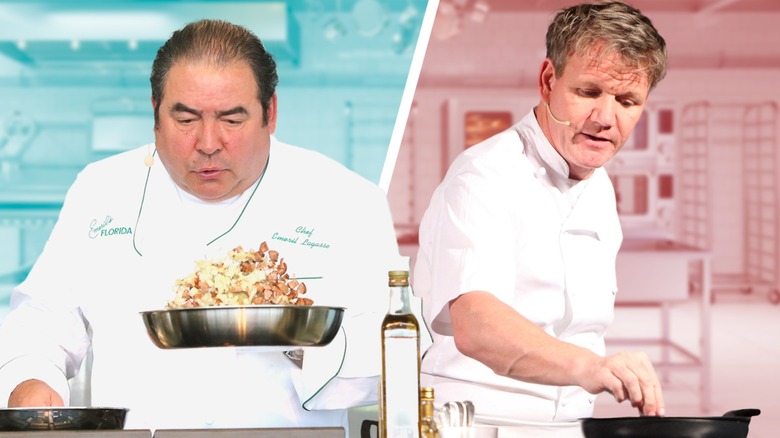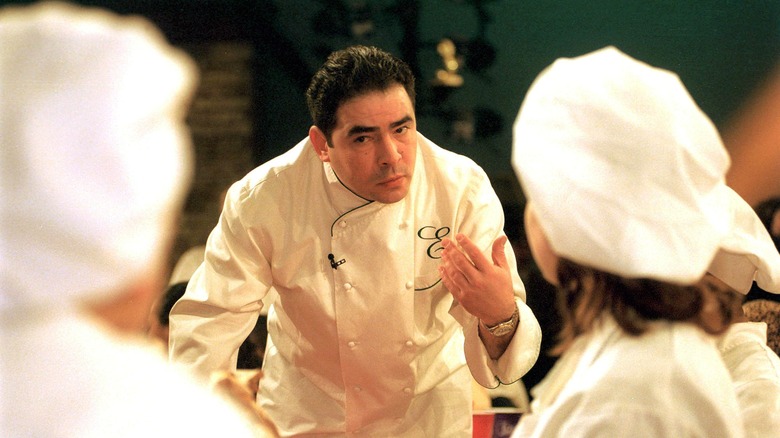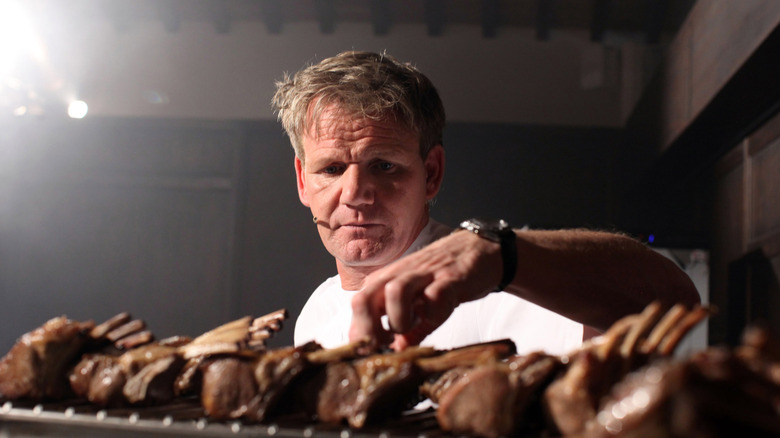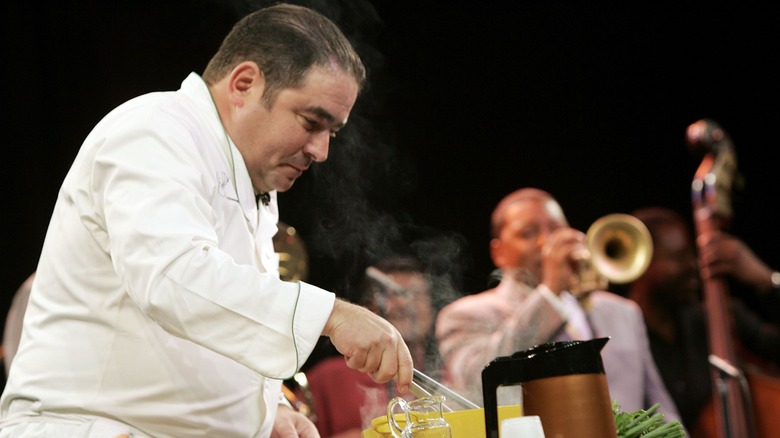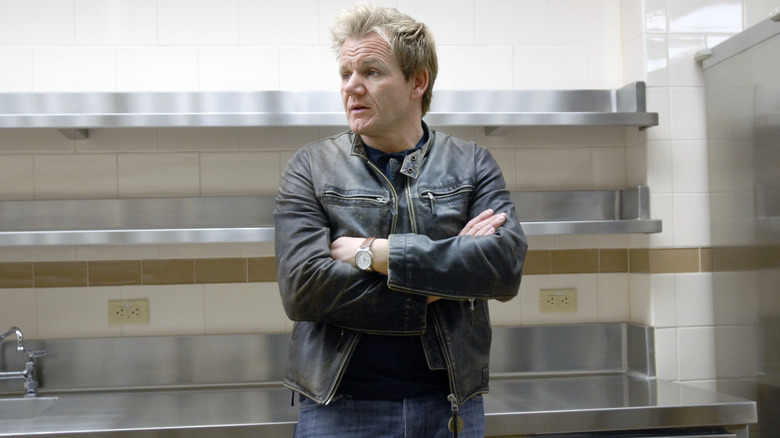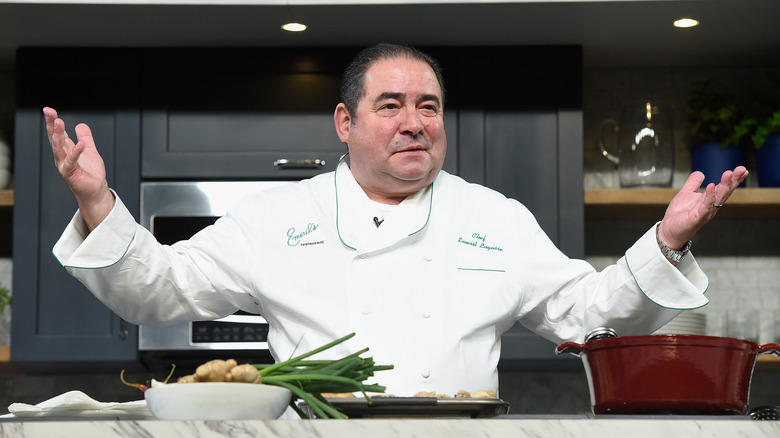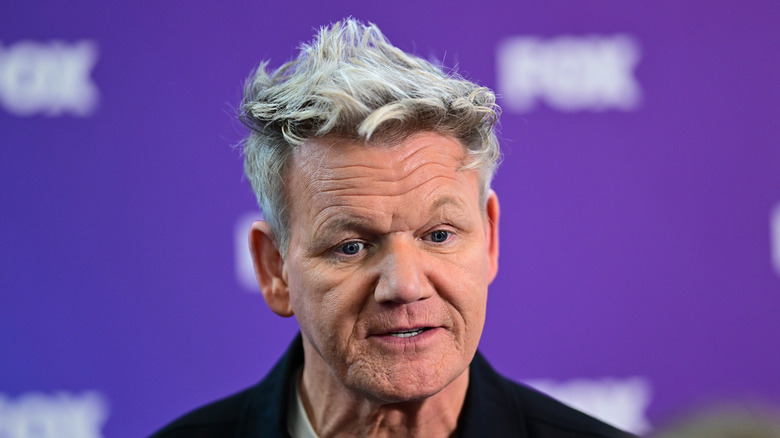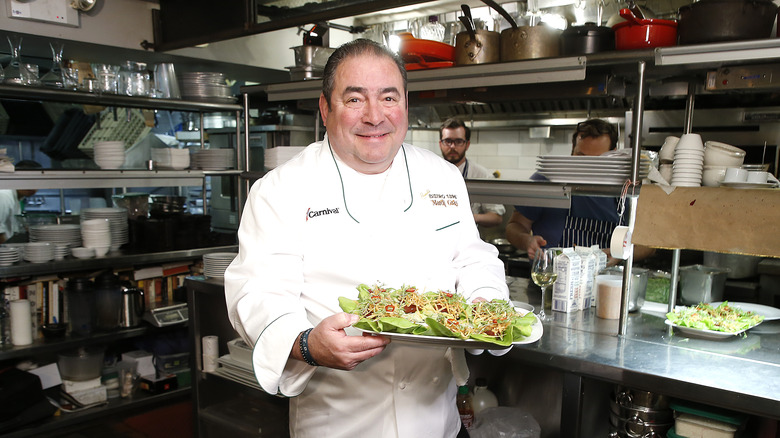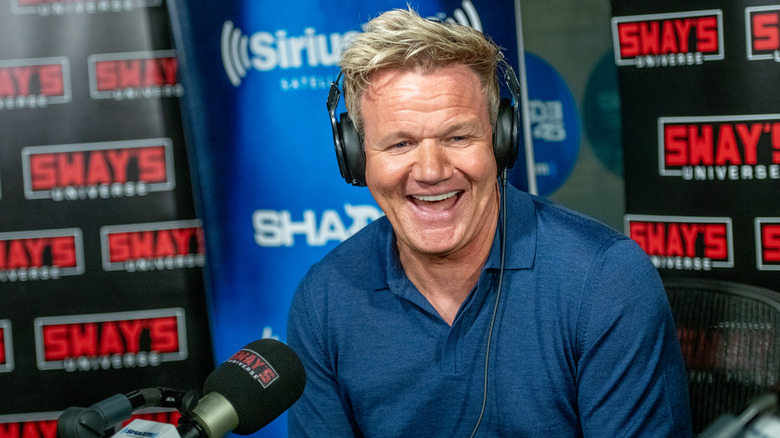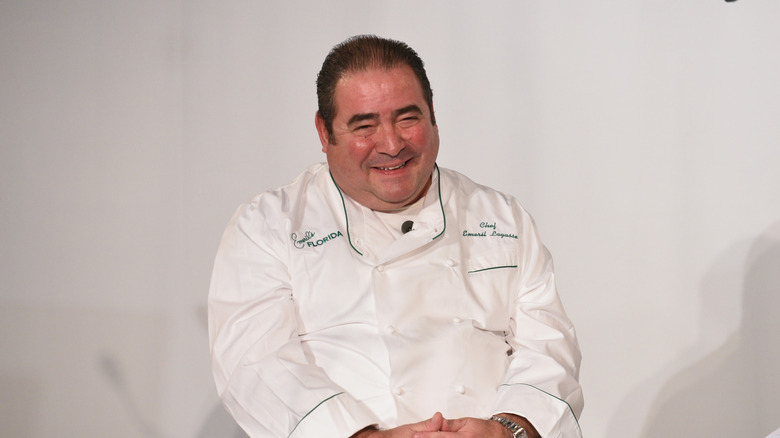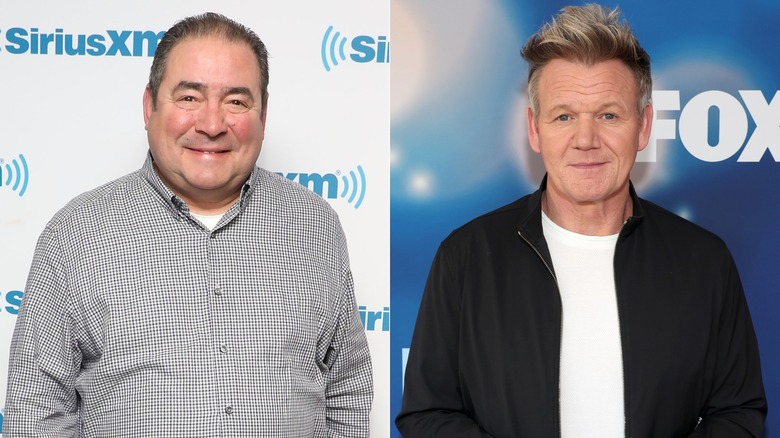Emeril Lagasse Vs Gordon Ramsay: The Differences In Cooking Styles
The idea of a food celebrity is in a constant state of flux, with social media food influencers receiving levels of clout once reserved for Food Network mainstays. Still, there are a few indisputable giants in food media without whom the industry would look very different. Two such people are Emeril Lagasse and Gordon Ramsay.
Over their carrers, Lagasse and Ramsay helped define celebrity chefdom as we know it, and their respective journeys to fame have at times mirrored one another, then deviated with each serpentine turn. Both chefs are known for their network of restaurants as well their food media careers. Lagasse became the head chef of New Orleans' storied Commander's Palace in 1982, and in 1990, he struck out on his own with his flagship Emeril's Restaurant. In 1993 Lagasse began his long-standing relationship with the Food Network by hosting "How to Boil Water" followed by his own shows, "Essence of Emeril" and "Emeril Live."
Ramsay followed a similar restaurant to food media pipeline, beginning with early restaurant stints at Harveys and Le Gavroche in London before decamping to Paris. The 1999 documentary series "Boiling Point" followed the chef as he opened Restaurant Gordon Ramsay in London. More television opportunities followed, including "Kitchen Nightmares," "Hell's Kitchen," and "MasterChef." In 2021, Lagasse and Ramsay finally teamed up for a Season 11 episode of Ramsay's "MasterChef." The two master chefs have certainly earned their stripes, albeit via very different approaches to their cooking styles and personal brands.
Emeril borrows from his Portuguese background
Emeril Lagasse was born in 1959 in Fall River, Massachusetts to a Portuguese mother, Hilda, and father John. Southeastern Massachusetts is the biggest Portuguese-American hub in the United States, and a young Lagasse soaked up the local Portuguese culinary culture. "One of my chores for my mom was, every day I would have to go down to the local Portuguese bakery and get bread for the table," Lagasse told CNN. At age 10, Lagasse went to work at Carreiro's Bakery, eventually graduating from washing dishes to baking muffins and bread.
As Lagasse's career took him to a culinary program at Johnson & Wales University in Providence, Rhode Island, then Europe, then New Orleans, the chef always held onto his Portuguese roots. Emeril's website is dotted with recipes for Portuguese favorites, including spicy salt cod cakes with chorizo and stewed fava beans and kale-filled caldo verde. The chef also admits that his mother's dishes continue to dominate at home and around the holidays. "The biggest influence is really my mom," he told Tasting Table, citing a Thanksgiving dish called lache, a Portuguese take on stuffing that features chorizo, bell pepper, celery, and onions.
As of this writing, Lagasse is slated to open 34 Restaurant & Bar, his first Portuguese restaurant, in New Orleans in spring 2024.
Ramsay's background is in French cuisine
While Lagasse's culinary background exhibits the American melting pot in action, Gordon Ramsay's culinary building blocks came from French cuisine. Born in Scotland and raised in England, Ramsay studied hotel management after a soccer injury kept him off the pitch.
In the 1980s, he moved to London, where he worked at the French restaurant Harveys under Marco Pierre White, the then-youngest chef to receive three Michelin stars. Wanting to further study French cuisine, Ramsay trained next under Albert Roux at Le Gavroche, the first restaurant in the United Kingdom to earn a Michelin star. At the age of 23, Ramsay moved to Paris where he found new mentors in Guy Savoy and Joël Robuchon. Upon returning to England, Ramsay demonstrated his command for French cooking at Aubergine and then his own restaurant established in 1998, Restaurant Gordon Ramsay.
Ramsay's mastery of French techniques have come to define his network of restaurants, but the chef has never strayed far from his British roots. Ramsay can whip up a beef Wellington like the best of them, for one. Of all of the times the chef has been asked his ideal final supper — "I've been asked that about 2,000 f***ing times," he once said, per a Reddit AMA — Ramsay has namechecked a roast with Yorkshire pudding, his mother's shepherd's pie, and a Scottish breakfast sandwich piled high with haggis.
Emeril is known for his New New Orleans cuisine
Despite hailing from Massachusetts, Emeril Lagasse has become synonymous with the food of New Orleans, even dubbing his take on the region's food as "New New Orleans" — a blend of Cajun and Creole cooking with contemporary techniques and influences from around the United States. The cooking style arguably helped to redefine dining in the Big Easy and served as the inspiration for Lagasse's first cookbook, 1993's "Emeril's New New Orleans Cooking."
Lagasse's reverence for New Orleans cooking began in 1982 when, at only 23, he succeeded executive chef Paul Prudhomme at Commander's Palace. No easy task, as Prudhomme is often credited with popularizing Cajun and Creole cuisine. According to the then-proprietor of Commander's Palace, Emma Brennan, Lagasse was more than willing to learn. "Emeril furthered the evolution of Haute Creole cuisine and expanded on what Paul had been doing with Cajun," Brennan recalled in Bon Appétit, "but he also brought his French-Canadian/Portuguese heritage — and his own insatiable curiosity — to bear on the menu."
Today, Lagasse is a Cajun and Creole authority, with a number of his restaurants – including Emeril's, NOLA, and Delmonico – focusing on Louisiana flavors. Indeed, Lagasse's New New Orleans recipes are some of his most beloved, with his dressed up version of NOLA-style BBQ Shrimp at the top of the list. "It's been on the menu since day one and is still, hands down, the number one dish," Lagasse told People.
Ramsay's hosting style is abrasive and foul-mouthed
Gordon Ramsay is known as much for his culinary accomplishments as he is for his fiery temper and inflammatory language. Kitchens are notorious pressure cookers for tightly wound, perfectionist chefs, and Ramsay came up under a few prototypical offenders. Marco Pierre White once reduced Ramsay to tears, and Guy Savoy was a known screamer too. Ramsay chalks this up to the culture. "I've been cooking since the age of 19, and I've never come across a namsy-wamsy, incy-pincy kitchen where everyone's a best mate," he told The New York Times, adding that a little pressure is necessary to get results.
Ramsay didn't let a little on-camera scrutiny curb his reputation. If anything, Ramsay's blooming media career only added fuel to the fire. His willingness to lash out at employees was on full display on "Boiling Point," and Ramsay leaned into his on-camera persona with series like "Kitchen Nightmares" and "Hell's Kitchen" where he made mincemeat of competitors and restaurateurs in vein-popping, f-bomb-laced fashion.
Ramsay insists that his on-screen persona is exaggerated, and that he is much more calm and affable when the cameras aren't rolling. Still, even Ramsay has admitted that he could take it down a notch. Yet, as he told The Guardian, "I don't want a radical change where I have to put a woolly hat and scarf on and go round every Women's Institute and improve their Victoria sponge or show them a much better recipe for spotted dick."
Emeril's hosting style is light and breezy (with a flair for catchphrases)
For all of the differences in their culinary backgrounds and restaurants, Lagasse and Ramsay differ most when it comes to their on-screen personas. Lagasse is the lighthearted yin to Ramsay's red-faced yang. With his fun and jovial approach, it is no surprise that Lagasse quickly became the Food Network's poster boy.
Beginning with "Essence of Emeril" in the mid-1990s, Lagasse proved to be an easygoing, enthusiastic on-screen presence. It is also where he honed his best-known catchphrase: "Bam!" According to the chef, the catchphrase was born out of production demands. To accommodate his busy restaurant schedule, eight episodes of "Essence of Emeril" were shot in one day. By the time the crew returned from their lunch break, the energy in the studio had gone down considerably. Lagasse began to punctuate his flambéing and seasoning with emphatic "bams" to keep everyone awake. That enthusiastic delivery blossomed on "Emeril Live," where the chef's showmanship was often met with riotous applause.
The off-screen Lagasse is considerably more sedate. In 2012, Anthony Bourdain wrote an episode of the HBO series "Treme" featuring Lagasse. Bourdain was eager to write a version of Lagasse that hewed closer to real life — one where the NOLA chef exhibited "the burden of years of responsibility for hundreds of people — an empire — on his shoulders," Bourdain told The Times-Picayune. "But also generous and loyal to his friends. I've seen that Emeril."
Ramsay has restaurants all over the world and multiple Michelin stars
Ramsay may be known for his televised histrionics, but he has the cooking clout to back it up. Ramsay currently owns more than 20 restaurant brands in 80 different locations. They run the gamut from French fine dining to burger joints to airport eateries.
Ramsay's massive restaurant footprint demonstrates his willingness to cook beyond the parameters of French cuisine. With locations in London, Manchester, and Miami, Lucky Cat is Ramsay's foray into Asian flavors. His sprawling network of casual restaurants includes multiple locations of Street Pizza, Street Burger, and Gordon Ramsay's Fish & Chips. And when we say sprawling, we mean it; Ramsay has restaurants in China, Qatar, Macau, Scotland, Thailand, Canada, and the United Arab Emirates, to name just a few countries.
Ramsay is the rare chef to pursue both casual dining and the upper echelons of fine dining — namely, Michelin stars, which are only bestowed to the top tier of restaurants. Throughout his career, Ramsay has earned an impressive 17 stars, with Restaurant Gordon Ramsay being the only three-star winner — a distinction it had held since 2001. Though Ramsay's restaurants span nations and cuisines, his Michelin-starred restaurants are in Europe and focus on his bread and butter: French fine dining. However, the Michelin guide can remove stars once they've been rewarded, a fact that has certainly kept Ramsay on his toes. In 2013, Ramsay lost two Michelin stars at The London in New York.
Emeril's restaurants are all stateside
Lagasse has a more reserved approach when it comes to opening restaurants. "We're not out to set any records," the chef told NOLA.com in 2013. " They have to be the right thing." It is perhaps that attitude that has resulted in Lagasse's empire remaining stateside, with restaurants in Louisiana, Nevada, and Florida.
Life as a restaurateur hasn't always been easy for Lagasse, and the chef has had to weather the Great Recession and the pandemic. In 2005, Hurricane Katrina destroyed three of his restaurants. Lagasse pulled himself out of restaurant ruin with the help of Martha Stewart, whose media company bought the rights to much of Lagasse's brand in 2008 (it's since been bought by another company).
Much like Ramsay, Lagasse's network of eateries has allowed him to expand beyond a single cuisine or style of cooking. Meril, a contemporary American restaurant, highlights global flavors as seen in the menu's cauliflower pad thai and Korean chicken wings, whereas Delmonico is a riff on the classic American steakhouse. Emeril's Brasserie is France-meets-French Quarter.
Lagasse's restaurants haven't yet won him any Michelin stars, but the chef has earned other awards and distinctions. He has been recognized by the James Beard Foundation Awards, winning Best Southeast Regional Chef in 1991 and Humanitarian of the Year in 2013 for his philanthropic efforts supporting children's education. Lagasse also won a Daytime Emmy Award in 2017 for his Amazon Prime series, "Eat the World with Emeril Lagasse."
Ramsay's robust media presence has endeared him to fans
Ramsay established himself as a TV star with shows like "Hell's Kitchen," "Kitchen Nightmares," and "MasterChef," and the media mogul is showing no signs of slowing. In 2021, Ramsay signed an overall deal with Fox Entertainment — a studio with whom he's had a relationship since "Hell's Kitchen" premiered in 2005 — to form Studio Ramsay Global. Since then, Ramsay has hosted "Next Level Chef" and "Gordon Ramsay's Food Stars" on the network. He has stayed busy elsewhere as well, hosting and producing series for National Geographic and BBC One.
Along the way, Ramsay has seamlessly made the transition from television personality to social media guru. For further proof, check out his impressive numbers. As of this writing, the chef boasts 17.4 million Instagram followers and 20.7 million YouTube subscribers, with both accounts serving to share recipes, post restaurant updates, advertise his TV appearances, and even boost his mentees.
Social media has given Ramsay more opportunities to shape his image, and his output suggests that he's moving away from his hot-headed reputation and embracing his role as a mentor and family man. This is most evident online, where he can be seen cooking with his children and sharing useful tips — all without screaming his head off. "I'm getting a bit tired of the foul-mouthed bully chef," Ramsay told The Guardian back in 2010. With his social media presence, that goal seems increasingly like it's been achieved.
Emeril has backed out of the spotlight to focus on cooking
Contrary to popular belief, Lagasse is indeed capable of taking it down a notch. Unlike Ramsay, Lagasse has backed out of the limelight a little at this point in his career — a significant counterpoint to his splashy, ubiquitous presence in the '90s and early 2000s. His restaurant empire has shrunk from a dozen locations to just a handful, and his army of employees that once totaled 1,600 is about half that number. No longer the face of the Food Network, Lagasse occupies himself with modest steaming series like "Emeril Cooks" and "Emeril Tailgates" on Roku+.
That's not to say that Lagasse has disappeared off the face of the earth. His 540,000 Instagram followers, for one, are nothing to sneeze at. The chef has also reiterated that he has no plans to retire anytime soon. Rather, Lagasse is refocusing his efforts towards dining. "For me, I'm really zeroed in on my restaurants," Lagasse said in an exclusive interview with Tasting Table. "That's really where I want to be. That's where I spend most of my time these days, other than taking short times to do the Roku show."
The appeal of the Roku series, Lagasse continued, is that they're shot in his home base of New Orleans. It's a far cry from the hectic scheduling of "Emeril Live" in the late '90s, which required the chef to fly to New York six times a year to tape 86 one-hour episodes.
Both chefs are savvy businesspeople
Lagasse and Ramsay are both renowned for their culinary pedigrees and successful restaurants, but they wouldn't have risen to the upper echelons of food celebrity without serious business savvy. Gordon Ramsay Holdings Limited was incorporated in 1997 and includes the chef's restaurant group, as well as other business ventures, while The Emeril Group handles Lagasse's restaurant operations, a test kitchen, and a store for his line of products.
Lagasse and Ramsay have personally-approved lines of cookware for those looking to emulate their favorite celebrity chefs. Ramsay endorsed cookware from HexClad, which also sells "Hell's Kitchen" branded spices, and Emeril Everyday offers cookware, indoor grills, and pasta makers, among other cooking supplies. Lagasse's company also doles out stocks, spices, and sauces with Lagasse's name and image emblazoned on the packaging. The Lagasse brand has also offered frozen snacks and refrigerated pasta.
Ramsay, too, entered the frozen food game in 2023 when he launched his own line of at-home dinners. It signaled a philosophical 180 for the chef, who once singled out frozen food as the one thing he would never eat. "It's so easy to prepare a quick meal using fresh produce, such as a simple stir-fry," he told Bon Appétit in 2009, "but people still resort to ready meals that all taste exactly the same."
